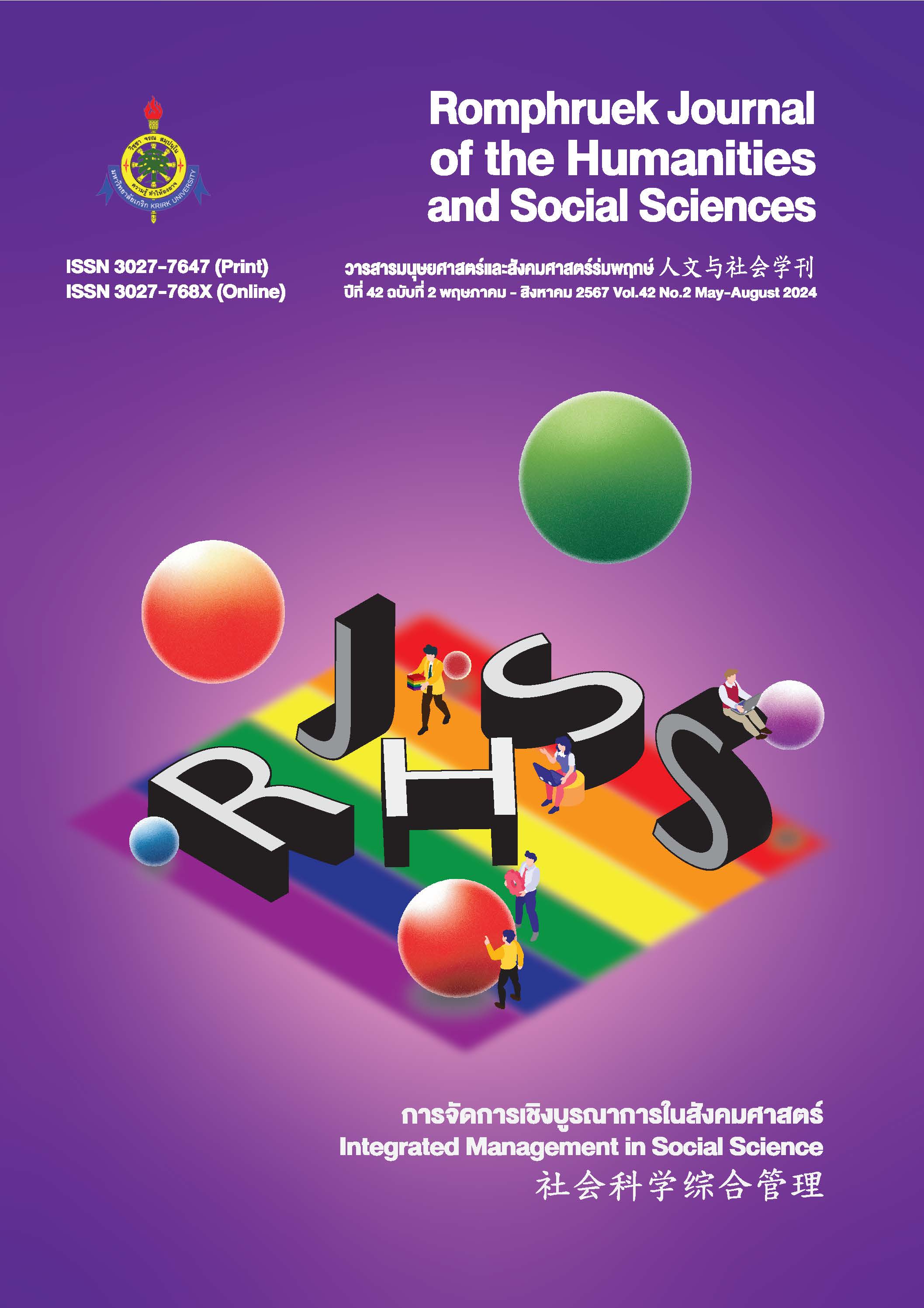The Influence of Work Stress and Burnout on Turnover Intentions of Private Office Workers in Nonthaburi Province
Main Article Content
Abstract
This research aims to investigate 1) the factors of work stress, 2) the burnout state, 3) the turnover intention, 4) the relationship between the work stress factors and the burnout state, 5) the burnout state that influences the turnover intention; and 6) the work stress factors that influence the turnover intention in private office workers in Nonthaburi Province. A questionnaire was used to collect data from 394 office workers, chosen by convenience sampling method. The data received were analyzed by frequency, percentage, mean, standard deviation, Pearson's correlation coefficient, and multiple regression analysis with statistically significant at the 0.05 level.
The findings indicated that: 1) the factors associated with work stress were at moderate level. The aspect of role and duty came in first, then organizational advancement, and interpersonal ties came in last. 2) The burnout state was at a moderate level. The feeling of exhaustion came in first, followed by the aspect of indifference, and the ability to work was the last. 3) The turnover intention was found at high level. The aspect of looking for a new job in the near future came in first, followed by thinking of resigning from their current job, and would leave this organization as soon as possible, respectively. 4) The factors of work stress had a moderate positive relationship with the burnout state. 5) Factors of work stress in terms of roles, work-life balance, advancement in the organization, and organizational characteristics affected the turnover intention with the prediction power of 38.8 percent. Lastly, 6) the burnout state in terms of exhaustion and cynicism affected the turnover intention with the prediction power of 47.5 percent.
Article Details

This work is licensed under a Creative Commons Attribution-NonCommercial-NoDerivatives 4.0 International License.
Every article published in the Romphruek Journal of the Humanities and Social Sciences is the opinion and point of view of the authors. Thery're not the viewpoint of Krirk University or the editored department. Any part or all of the articles for pablication must be clearly cited.
References
กรมพัฒนาธุรกิจการค้า กระทรวงพาณิชย์. (ม.ป.ป.). นิติบุคคลที่ดำเนินกิจการอยู่ (ราย) ปี พ.ศ. 2566. Datawarehouse. https://datawarehouse.dbd.go.th/area/overview
เพ็ญพิชชา เกตุชัยโกศล. (2564). ภาวะหมดไฟในการทำงาน (Burnout) ของพนักงานบริษัทเอกชน ในกลุ่ม Generation Y (วิทยานิพนธ์ปริญญามหาบัณฑิต, มหาวิทยาลัยมหิดล). CMMU Digital Archive.
https://archive.cm.mahidol.ac.th/handle/123456789/4127.
วัฒนา ศรีวิลัย และ กล้าหาญ ณ น่าน. (2564). ความเครียดและความเหนื่อยหน่ายในการทำงานที่มีอิทธิพลต่อผลการปฏิบัติงานของพนักงาน กรณีศึกษา: บริษัท ไฟน์ เม็ททัล เทคโนโลยีส์ จำกัด (มหาชน). วารสารวิชาการวิทยาลัยสันตพล, 7(2), 34-42.
วรัญพงศ์ บุญศิริธรรมชัย กุลกานต์ เมเวส และ พลอย สุดอ่อน. (2565). ปัจจัยที่ส่งผลต่อผลการปฏิบัติงานและความตั้งใจในการลาออกของพนักงาน กรณีศึกษา: ในกลุ่มพนักงานวิศวกรเจเนอเรชั่น Y ในเขตกรุงเทพมหานคร. วารสารบริหารธุรกิจและการบัญชี มหาวิทยาลัยขอนแก่น, 6(2), 1-18.
Cochran, W.G. (1977). Sampling Techniques (3rd ed.). John Wiley and Sons.
Cooper, C. L., Dewe, P. J., & O'Driscoll, M. P. (2001). Organizational stress: A review and critique of theory, research, and applications. Sage Publicationsd.
Hair, J., Black, W. C., Babin, B. J. & Anderson, R. E. (2010). Multivariate data analysis (7th ed.). Pearson.
Hargrove, M. B., Nelson, D. L., & Cooper, C. L. (2013). Generating eustress by challenging employees. Organizational Dynamics, 42(1), 61–69. https://doi.org/10.1016/j.orgdyn.2012.12.008.
Hinkle, D.E. (1998). Applied Statistics for the Behavioral Sciences. Houghton Mifflin.
Maslach, C. & Jackson, S.E. (1981). The Measurement of Experienced Burnout. Journal of Organizational Behavior, 2(2), 99-113. https://doi.org/10.1002/job.4030020205.
Maslach, C., & Leiter, M. P. (2008). Early predictors of job burnout and engagement. Journal of Applied Psychology, 93(3), 498–512. https://doi.org/10.1037/0021-9010.93.3.498.
Mercer. (2022, 25 November). Total Remuneration Survey. Brandage. https://brandage.com/article/33474.
Mobley, W.H., Horner, S.O. & Hollingsworth, A.T. (1978). An Evaluation of Precursors of Hospital Employee Turnover. Journal of Applied Psychology, 63(4), 408-414. https://doi.org/10.1037/0021-9010.63.4.408.
Mobley, W. H. (1982). Employee Turnover: Causes, Consequences, and Control. Addision- Wesley.
Mowday, R. T., Steers, R. M., & Porter, L. W. (1979). The Measurement of Organizational Commitment. Journal of Vocational Behavior, 14(2), 224-247. https://doi.org/10.1016/0001-8791(79)90072-1.
Robbins, S. P., & Judge, T. A. (2021). Essentials of Organizational Behaviour (15th ed.). Pearson.
Salama, W., Abdou, A. H., Mohamed, S. A. K., & Shehata, H. S. (2022). Impact of Work Stress and Job Burnout on Turnover Intentions among Hotel Employees. International Journal of Environmental Research and Public Health, 19(15), 9724. https://doi.org/10.3390/ijerph19159724


